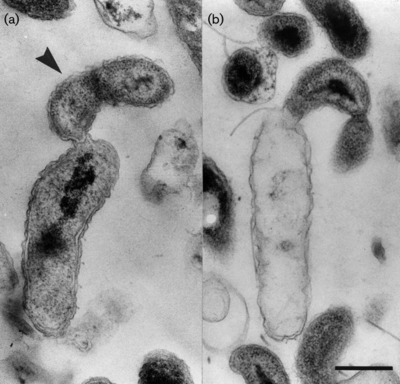Bdellovibrio exovorus
Classification
Higher order taxa
Domain: Bacteria
Phylum: Proteobacteria
Class: Deltaproteobacteria
Order: Bdellovibrionales
Family: Bdellovibrionaceae
Species
|
NCBI: [1] |
Bdellovibrio exovorus
Description and significance
a. Bdellovibrio exovorus is a parasitic bacterium whose name means “Leech-like vibrating outside-devourer.” (Gr. Bdella, leech, sucker; L. vibrio, vibrating; Gr. exo-, outside, L. vorus, to eat.) B. exovorus was first isolated from sewage in London, Ontario, Canada, and sequenced in 2013 by the Weizmann Institute of Science.
b. B. exovorus are gram-negative, comma-shaped rods, about 0.5 um wide and 0.5-1.4 um long. They have a single, polar, sheathed flagellum that is 29 nm wide. These predatory bacteria have 2 phases in their life cycle: first, they swim freely to attack bacteria, and second they attach to the outside of their prey. Unlike their closest relative B. bacteriovorus, they do not burrow inside their prey cell, they have no periplasmic stage, and they do not form a bdelloplast. B. exovorus undergoes cell division via binary fission while attached to the prey cell. As it feeds, it leaves behind small plaques on the empty husks of their stalked prey cells. B. exovorus' most common prey cell is Caulobacter crescentus, and actually will not prey upon Escherichia coli.
Existing genus MicrobeWiki Link: https://microbewiki.kenyon.edu/index.php/Bdellovibrio
Genome and genetics
a. To what major branch of the prokaryotes do they belong? (see textbook or Bergey’s). List 2-3 closely related but separate species or genera of bacteria.
b. Briefly describe any extra-chromosomal elements or genetic tools that are used to study the bacterium: viruses, plasmids, transposons that allow genetic manipulation and analysis.
c. Has the genome or genomes been sequenced? If so, include the website for the database and one or two highlights of the genome. Also indicate genome size (base pairs), %G+C (nucleotide base composition) and number of genes, and specific genes or gene regions that are unique to this organism. If it has not been sequenced, give its closest relative that has been sequenced, its website, and some general information about the related sequence.
Example: The sequence of Haemophilus influenzae was determined using whole genome shotgun sequencing (Fleischmann et al. 1995).
Nutrition and metabolism
a.Describe the growth characteristics of your bacterial species; sources of C, N, electrons; respires/ferments, uses O2, etc.
b.What kinds of culture conditions (temp, pH, media) are needed for laboratory study?
c.What kinds of waste, by-products, volatile compounds are generated?
Ecology / Pathology
Ecology: How is your microorganism important in the ecosystem where it is found? How does it impact other organisms in the environment (could be positive or negative impact)?
Pathology: How does the microbe cause disease as it interacts with the host? Describe any specific toxins or pathways that are used for invading and causing disease in the host. What treatment is used to inhibit or kill the microbe?
Current Research
Describe recent research and findings that have been done with this organism. The research can be clinical, applied or basic research. This section should be based on 2 recent papers (10 years or less) and summarized in your own words.
References
The format for citations and for the “References” list will follow the “Citation—Name” Council of Science Editors (CSE) format, as the suggested formatting method listed on the MicrobeWiki Home page. The reference list will be numbered based on an alphabetical list of the first author’s last name.
A style guide for the CSE format can be found here: http://writing.wisc.edu/Handbook/DocCSE_CitationSystems.html.
For an example, see this entry: https://microbewiki.kenyon.edu/index.php/Bacillus_anthracis
[2] Koval, SF, Hynes, SH, Flannagan, RS, Pasternak, Z, Davidov Y, Jurkevitch E. Bdellovibrio exovorus sp. nov., a novel predator of Caulobacter crescentus. Int. J. Syst. Evol. Microbiol [Internet]. 2013 [cited 13 Feb 2017; (63):146–151.
[3] Bdellovibrio exovorus JSS [internet]. University of California- Integrated Microbial Genomes & Microbial Samples. [cited 2017 Feb 13] Availible from https://img.jgi.doe.gov/cgi-bin/m/main.cgi?section=TaxonDetail&page=taxonDetail&taxon_oid=2541047022
Authored by [Kip Pierce], a student of CJ Funk at John Brown University

